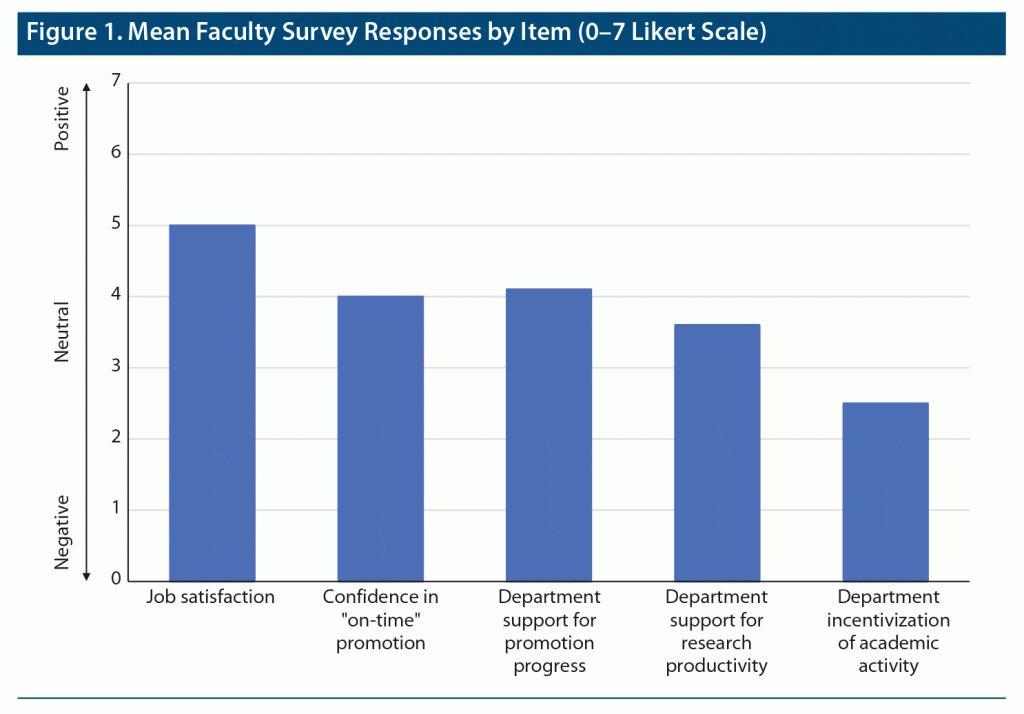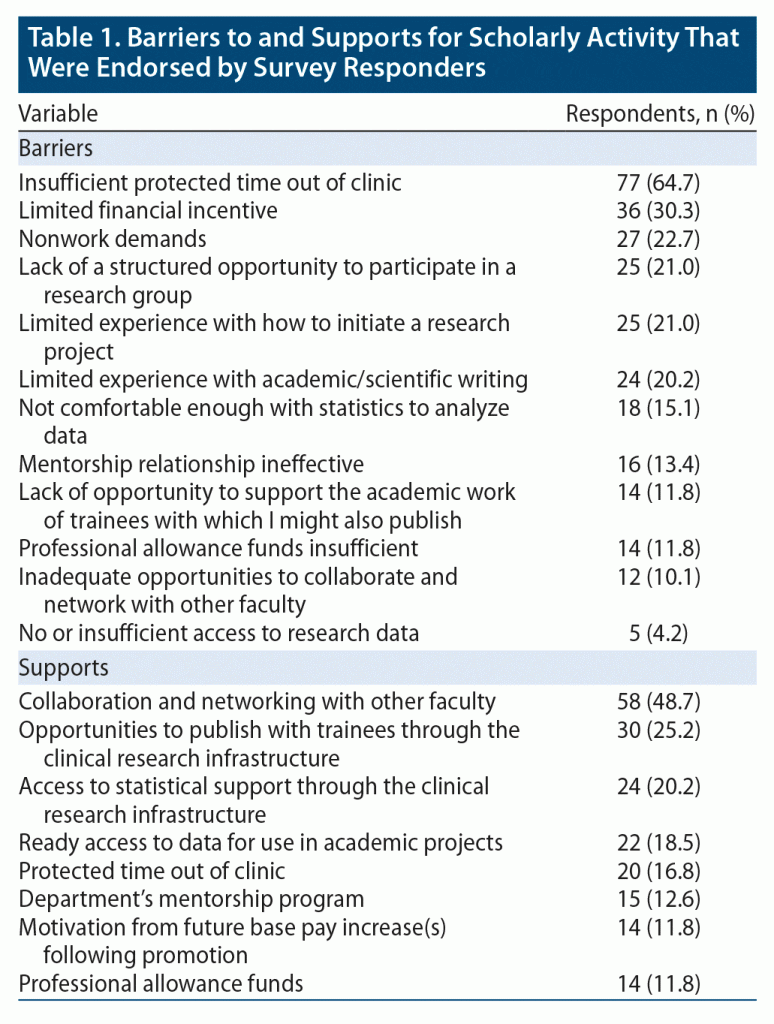
Prim Care Companion CNS Disord 2022;24(3):21br03193
To cite: Robinson RJ, Brown ES. A needs assessment survey to identify barriers and supports for developing scholarly activity among clinician educators. Prim Care Companion CNS Disord. 2022;24(3):21br03193.
To share: https://doi.org/10.4088/PCC.21br03193
© Copyright 2022 Physicians Postgraduate Press, Inc.
aDepartment of Psychiatry, University of Texas Southwestern Medical Center, Dallas, Texas
*Corresponding author: E. Sherwood Brown, MD, PhD, MBA, Department of Psychiatry, University of Texas Southwestern Medical Center, 5323 Harry Hines Blvd, Dallas, TX 75232 ([email protected]).
Clinical faculty must balance clinical care, education, and research/scholarship. Failure to balance clinical productivity with the education and research missions in academia can lead to diminishing clinical revenue, as well as faculty burnout.1–3 A survey of clinical psychiatry faculty was conducted to identify factors that support and prevent scholarly activity.
METHODS
To identify challenges to and facilitators of scholarly activity by clinician educator psychiatry faculty, UT Southwestern Institutional Review Board approval was obtained to conduct an anonymous survey in July 2019. Questions included demographic information, such as academic rank, years of experience, sex, age, race, and ethnicity. Five questions on a 0–7 Likert scale assessed faculty appraisal of various job-related factors. The first 2 questions addressed job satisfaction and confidence in getting promoted “on schedule.” The next 2 items solicited ratings regarding faculty perception of the degree to which the department has been helpful in supporting their (1) research productivity and (2) progress toward promotion. Although similar, these items were treated separately in case faculty felt well-supported in promotion efforts, but not necessarily supported in academic/research productivity. The fifth item asked faculty to rate the extent that they felt incentivized to be academically productive. For context, the department in question had a performance incentive that rewarded clinical (but not academic) productivity. Finally, respondents were also asked to identify barriers and supports to academic productivity from lists of options for each.
RESULTS
A total of 119 of the 218 clinical faculty in the psychiatry department completed the survey (54.6% response rate). Of the sample, 47.9% were assistant professors, 31.9% had been on the faculty for ≤ 3 years, 47.1% were women, 59.7% were white, 5.0% were of Hispanic ethnicity, and 37.0% were between the ages of 36 and 50 years. The mean ± SD faculty job satisfaction score was 5.0 ± 1.5 (0–7 scale) (Figure 1). The mean ± SD score on the question regarding “confidence in promotion in 6–8 years” was 4.0 ± 2.3. The mean ± SD score on the question about departmental support for progress toward promotion was 4.1 ± 1.8. The mean ± SD score on the question regarding departmental help in supporting academic productivity was 3.6 ± 1.6.
The most endorsed barriers to academic productivity included insufficient protected time, limited financial incentive, nonwork demands, lack of structured opportunity to participate in a clinical research group, limited experience about how to initiate a research project, limited experience with academic/scientific writing, not being sufficiently comfortable with statistics to analyze data, and ineffective mentorship relationship (Table 1). The top supports were collaboration and networking with other faculty, opportunities to publish with trainees, access to statistical support, access to data, and protected time out of the clinic.
Overall satisfaction demonstrated a statistically significant relationship with the rating for extent of support for academic productivity (r = 0.54, P < .001), support for progress toward promotion (r = 0.56, P < .001), and extent of incentivization for academic productivity (r = 0.52, P < .001) but not with confidence in being promoted on schedule (r = 0.16, P = .18).
DISCUSSION
The respondents were generally early in their careers. Overall satisfaction was fairly high and associated with the perception of supports provided. The survey findings can, to some extent, be divided into those related to time for scholarship and work/life balance and those related to lack of knowledge or experience.
The results suggest several directions for facilitating clinician scholarship. Perceived need for protected time and financial incentives were the most common barriers cited and might be the most challenging needs for a clinical department to address. Providing protected time away from clinical care or financially rewarding publishing papers has associated opportunity costs for generating clinical income to offset salary. Modest bonuses for meeting specified publication goals might be less costly than the revenue loss from providing additional protected time. Reimbursement for travel costs to meetings would incentivize scientific presentations.
A less costly option to help faculty with the challenges of limited available time could be writing groups that meet regularly at a convenient time and create accountability. Grzybowski and colleagues4 reported that a physician peer support writing club developed in a family practice department increased publications about 10-fold among frequent attendees.
The survey also identified a need for collaboration and mentorship, and the supports for scholarship item identified helpful initiatives including the statistical support provided by the department. In terms of initiatives that a department might consider to address these needs, a writing group that brings faculty members together regularly might help fill the need for networking and collaboration. Mentoring could be provided by clinical researchers or clinician educators who frequently publish. Within our department, we developed a group-based approach that teamed a clinical researcher with faculty at a clinical site.5 We found that this approach could be quite successful but required the availability of highly engaged clinical researchers. Our department also has a monthly seminar series in which research faculty and trainees present ideas or challenges and receive feedback.6 This approach might be easily emulated to develop clinical and education faculty scholarship.
Lack of knowledge about how to conduct research or analyze data was also identified as a barrier and can be particularly challenging for clinicians who may have received limited instruction in research methods during their training. A report by Reader et al7 showed that a multimodal intervention for clinicians (including protected time, writing retreats, seminars, small group and individual meetings, and a poster fair) was associated with the development of publications and presentations. This approach with multiple elements to assist with scholarly activity might help faculty develop their research skills, while providing regularly scheduled time for writing.
In summary, with increasing clinical care demands, clinician educators face many barriers to developing publications and other scholarly products. The survey identified lack of time and the skills and knowledge needed to publish as major barriers. Options to facilitate publications include writing groups, didactics, protected time, and financial incentives.
Submitted: November 18, 2021; accepted January 12, 2022.
Published online: April 26, 2022.
Relevant financial relationships: None.
Funding/support: None.
References (7)

- Berger TJ, Ander DS, Terrell ML, et al. The impact of the demand for clinical productivity on student teaching in academic emergency departments. Acad Emerg Med. 2004;11(12):1364–1367. PubMed CrossRef
- Massarweh NN, LeMaire SA, Merkow RP. Preserving an academic mission in the face of clinical productivity targets: where is the academic surgeon’s carrot? Ann Surg. 2020;271(2):223–224. PubMed CrossRef
- Nassar AK, Waheed A, Tuma F. Academic clinicians’ workload challenges and burnout analysis. Cureus. 2019;11(11):e6108. PubMed CrossRef
- Grzybowski SC, Bates J, Calam B, et al. A physician peer support writing group. Fam Med. 2003;35(3):195–201. PubMed
- Brown ES, Robinson RJ. A group-based approach to boosting scholarly productivity in clinical faculty. Acad Psychiatry. 2021;45(4):524–525. PubMed CrossRef
- Brown ES. Developing a sustained and productive clinical research seminar. J Clin Psychopharmacol. 2021;41(5):614–615. PubMed CrossRef
- Reader S, Fornari A, Simon S, et al. Promoting faculty scholarship an evaluation of a program for busy clinician-educators. Can Med Educ J. 2015;6(1):e43–e60. PubMed CrossRef
Please sign in or purchase this PDF for $40.
Save
Cite


